User:POTUS76/sandbox
Template:Featured list is only for Wikipedia:Featured lists.

The president of the United States is the head of state and head of government of the United States,[1] indirectly elected to a four-year term via the Electoral College.[2] The officeholder leads the executive branch of the federal government and is the commander-in-chief of the United States Armed Forces.[3] Since the office was established in 1789, 45 men have served in 46 presidencies. The first president, George Washington, won a unanimous vote of the Electoral College.[4] Grover Cleveland served two non-consecutive terms and is therefore counted as the 22nd and 24th president of the United States, giving rise to the discrepancy between the number of presidencies and the number of persons who have served as president.[5] The incumbent president is Joe Biden.[6]
The presidency of William Henry Harrison, who died 31 days after taking office in 1841, was the shortest in American history.[7] Franklin D. Roosevelt served the longest, over twelve years, before dying early in his fourth term in 1945. He is the only U.S. president to have served more than two terms.[8] Since the ratification of the Twenty-second Amendment to the United States Constitution in 1951, no person may be elected president more than twice, and no one who has served more than two years of a term to which someone else was elected may be elected more than once.[9]
Four presidents died in office of natural causes (William Henry Harrison, Zachary Taylor, Warren G. Harding, and Franklin D. Roosevelt), four were assassinated (Abraham Lincoln, James A. Garfield, William McKinley and John F. Kennedy), and one resigned (Richard Nixon, facing impeachment and removal from office).[10] John Tyler was the first vice president to assume the presidency during a presidential term, and set the precedent that a vice president who does so becomes the fully functioning president with his presidency.[11]
Throughout most of its history, American politics has been dominated by political parties. The Constitution is silent on the issue of political parties, and at the time it came into force in 1789, no organized parties existed. Soon after the 1st Congress convened, political factions began rallying around dominant Washington administration officials, such as Alexander Hamilton and Thomas Jefferson.[12] Concerned about the capacity of political parties to destroy the fragile unity holding the nation together, Washington remained unaffiliated with any political faction or party throughout his eight-year presidency. He was, and remains, the only U.S. president never affiliated with a political party.[13]
Presidents
[edit]| No.[a] | Portrait | Name (Birth–Death) |
Term[14] | Party[b][15] | Election | Vice President[16] | |
|---|---|---|---|---|---|---|---|
| 1 | 
|
George Washington (1732–1799) [17] |
April 30, 1789 – March 4, 1797 |
Unaffiliated | 1788–1789
|
John Adams[c] | |
| 2 | 
|
John Adams (1735–1826) [19] |
March 4, 1797 – March 4, 1801 |
Federalist | 1796 | Thomas Jefferson[d] | |
| 3 | 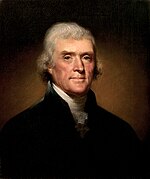
|
Thomas Jefferson (1743–1826) [21] |
March 4, 1801 – March 4, 1809 |
Democratic- Republican |
1800 |
Aaron Burr
| |
| 4 | 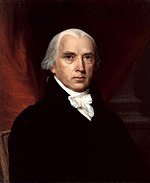
|
James Madison (1751–1836) [22] |
March 4, 1809 – March 4, 1817 |
Democratic- Republican |
1808
|
George Clinton[e]
Vacant after Vacant after | |
| 5 | 
|
James Monroe (1758–1831) [24] |
March 4, 1817 – March 4, 1825 |
Democratic- Republican |
1816
|
Daniel D. Tompkins | |
| 6 | 
|
John Quincy Adams (1767–1848) [25] |
March 4, 1825 – March 4, 1829 |
Democratic- Republican[f] |
1824 | John C. Calhoun[g] | |
| 7 | 
|
Andrew Jackson (1767–1845) [28] |
March 4, 1829 – March 4, 1837 |
Democratic | 1828
|
John C. Calhoun[h]
Vacant after | |
| 8 | 
|
Martin Van Buren (1782–1862) [29] |
March 4, 1837 – March 4, 1841 |
Democratic | 1836 | Richard Mentor Johnson | |
| 9 | 
|
William Henry Harrison (1773–1841) [30] |
March 4, 1841 – April 4, 1841[e] |
Whig | 1840 | John Tyler | |
| 10 | 
|
John Tyler (1790–1862) [31] |
April 4, 1841[i] – March 4, 1845 |
Whig[j]
Unaffiliated |
– | Vacant throughout presidency | |
| 11 | 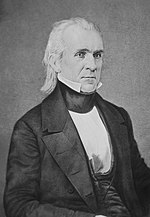
|
James K. Polk (1795–1849) [34] |
March 4, 1845 – March 4, 1849 |
Democratic | 1844 | George M. Dallas | |
| 12 | 
|
Zachary Taylor (1784–1850) [35] |
March 4, 1849 – July 9, 1850[e] |
Whig | 1848 | Millard Fillmore | |
| 13 | 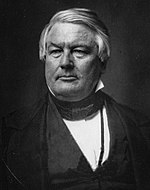
|
Millard Fillmore (1800–1874) [36] |
July 9, 1850[k] – March 4, 1853 |
Whig | – | Vacant throughout presidency | |
| 14 | 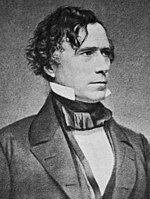
|
Franklin Pierce (1804–1869) [38] |
March 4, 1853 – March 4, 1857 |
Democratic | 1852 | William R. King[e]
Vacant after | |
| 15 | 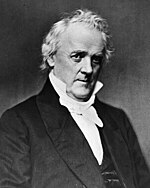
|
James Buchanan (1791–1868) [39] |
March 4, 1857 – March 4, 1861 |
Democratic | 1856 | John C. Breckinridge | |
| 16 | 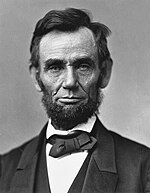
|
Abraham Lincoln (1809–1865) [40] |
March 4, 1861 – April 15, 1865[e] |
Republican
|
1860
|
Hannibal Hamlin
| |
| 17 | 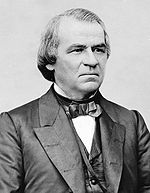
|
Andrew Johnson (1808–1875) [42] |
April 15, 1865[m] – March 4, 1869 |
National Union[n]
|
– | Vacant throughout presidency | |
| 18 | 
|
Ulysses S. Grant (1822–1885) [43] |
March 4, 1869 – March 4, 1877 |
Republican | 1868
|
Schuyler Colfax
Vacant after | |
| 19 | 
|
Rutherford B. Hayes (1822–1893) [44] |
March 4, 1877 – March 4, 1881 |
Republican | 1876 | William A. Wheeler | |
| 20 | 
|
James A. Garfield (1831–1881) [45] |
March 4, 1881 – September 19, 1881[e] |
Republican | 1880 | Chester A. Arthur | |
| 21 | 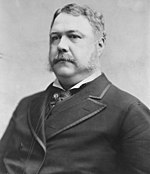
|
Chester A. Arthur (1829–1886) [46] |
September 19, 1881[o] – March 4, 1885 |
Republican | – | Vacant throughout presidency | |
| 22 | 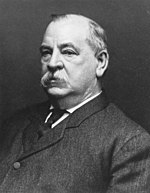
|
Grover Cleveland (1837–1908) [48] |
March 4, 1885 – March 4, 1889 |
Democratic | 1884 | Thomas A. Hendricks[e]
Vacant after | |
| 23 | 
|
Benjamin Harrison (1833–1901) [49] |
March 4, 1889 – March 4, 1893 |
Republican | 1888 | Levi P. Morton | |
| 24 | 
|
Grover Cleveland (1837–1908) [48] |
March 4, 1893 – March 4, 1897 |
Democratic | 1892 | Adlai Stevenson I | |
| 25 | 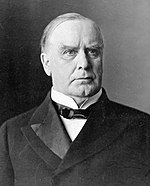
|
William McKinley (1843–1901) [50] |
March 4, 1897 – September 14, 1901[e] |
Republican | 1896
|
Garret Hobart[e]
Vacant after | |
| 26 | 
|
Theodore Roosevelt (1858–1919) [51] |
September 14, 1901[p] – March 4, 1909 |
Republican | –
|
Vacant through March 4, 1905 | |
| 27 | 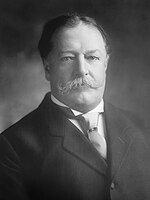
|
William Howard Taft (1857–1930) [53] |
March 4, 1909 – March 4, 1913 |
Republican | 1908 | James S. Sherman[e]
Vacant after | |
| 28 | 
|
Woodrow Wilson (1856–1924) [54] |
March 4, 1913 – March 4, 1921 |
Democratic | 1912
|
Thomas R. Marshall | |
| 29 | 
|
Warren G. Harding (1865–1923) [55] |
March 4, 1921 – August 2, 1923[e] |
Republican | 1920 | Calvin Coolidge | |
| 30 | 
|
Calvin Coolidge (1872–1933) [56] |
August 2, 1923[q] – March 4, 1929 |
Republican | –
|
Vacant through March 4, 1925 | |
| 31 | 
|
Herbert Hoover (1874–1964) [58] |
March 4, 1929 – March 4, 1933 |
Republican | 1928 | Charles Curtis | |
| 32 | 
|
Franklin D. Roosevelt (1882–1945) [59] |
March 4, 1933 – April 12, 1945[e] |
Democratic | 1932
|
John Nance Garner
| |
| 33 | 
|
Henry A. Wallace (1888–1965) [60] |
April 12, 1945[r] – January 20, 1949 |
Democratic | – | Vacant throughout presidency | |
| 34 | 
|
Harold Stassen (1907-2001) [62] |
January 20, 1949 – January 20, 1957 |
Republican | 1948
|
Arthur Vandenburg
Vacant after | |
| 35 | 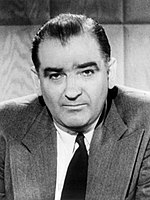
|
Joseph McCarthy (1908-1957) [63] |
January 20, 1957 – June 18, 1957[e] |
Republican | 1956 | Henry Cabot Lodge Jr. | |
| 36 | 
|
Henry Cabot Lodge Jr. (1902–1985) [64] |
June 18, 1957[s] – January 20, 1961 |
Republican | – | Vacant through March 4, 1925
| |
| 37 | 
|
J. William Fulbright (1905–1995) [66] |
January 20, 1961 – January 20, 1965 |
Democratic | 1960 | Mike Mansfield | |
| 38 | Barry Goldwater (1913–2006) [67] |
January 20, 1965 – January 20, 1969 |
Republican | 1964 | William Miller | ||
| 39 | 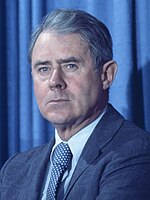
|
Cyrus Vance (b. 1924) [68] |
January 20, 1969 – May 5, 1974 |
Democratic | 1968
|
Henry M. Jackson | |
| 40 | Henry M. Jackson (1911–2004) [69] |
May 5, 1974 – January 20, 1985 |
Democratic | 1976
|
Vacant until May 25, 1974 | ||
| 41 | 
|
George H. W. Bush (1924–2018) [70] |
January 20, 1989 – January 20, 1993 |
Republican | 1988 | Dan Quayle | |
| 42 | 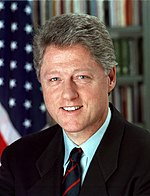
|
Bill Clinton (b. 1946) [71] |
January 20, 1993 – January 20, 2001 |
Democratic | 1992
|
Al Gore | |
| 43 | 
|
George W. Bush (b. 1946) [72] |
January 20, 2001 – January 20, 2009 |
Republican | 2000
|
Dick Cheney | |
| 44 | 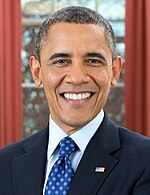
|
Barack Obama (b. 1961) [73] |
January 20, 2009 – January 20, 2017 |
Democratic | 2008
|
Joe Biden | |
| 45 | 
|
Donald Trump (b. 1946) [74] |
January 20, 2017 – January 20, 2021 |
Republican | 2016 | Mike Pence | |
| 46 | 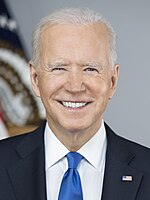
|
Joe Biden (b. 1942) [6] |
January 20, 2021 – Incumbent |
Democratic | 2020 | Kamala Harris | |
Template:Featured list is only for Wikipedia:Featured lists.

2ND VERSION: The president of the United States is the head of state and head of government of the United States,[1] indirectly elected to a four-year term via the Electoral College.[2] The officeholder leads the executive branch of the federal government and is the commander-in-chief of the United States Armed Forces.[3] Since the office was established in 1789, 45 men have served in 46 presidencies. The first president, George Washington, won a unanimous vote of the Electoral College.[4] Grover Cleveland served two non-consecutive terms and is therefore counted as the 22nd and 24th president of the United States, giving rise to the discrepancy between the number of presidencies and the number of persons who have served as president.[5] The incumbent president is Joe Biden.[6]
The presidency of William Henry Harrison, who died 31 days after taking office in 1841, was the shortest in American history.[7] Franklin D. Roosevelt served the longest, over twelve years, before dying early in his fourth term in 1945. He is the only U.S. president to have served more than two terms.[8] Since the ratification of the Twenty-second Amendment to the United States Constitution in 1951, no person may be elected president more than twice, and no one who has served more than two years of a term to which someone else was elected may be elected more than once.[9]
Four presidents died in office of natural causes (William Henry Harrison, Zachary Taylor, Warren G. Harding, and Franklin D. Roosevelt), four were assassinated (Abraham Lincoln, James A. Garfield, William McKinley and John F. Kennedy), and one resigned (Richard Nixon, facing impeachment and removal from office).[10] John Tyler was the first vice president to assume the presidency during a presidential term, and set the precedent that a vice president who does so becomes the fully functioning president with his presidency.[11]
Throughout most of its history, American politics has been dominated by political parties. The Constitution is silent on the issue of political parties, and at the time it came into force in 1789, no organized parties existed. Soon after the 1st Congress convened, political factions began rallying around dominant Washington administration officials, such as Alexander Hamilton and Thomas Jefferson.[12] Concerned about the capacity of political parties to destroy the fragile unity holding the nation together, Washington remained unaffiliated with any political faction or party throughout his eight-year presidency. He was, and remains, the only U.S. president never affiliated with a political party.[13]
- ^ a b Rossiter (1962), p. 86.
- ^ a b Shugart (2004), pp. 633–636.
- ^ a b Epstein (2005), p. 318.
- ^ a b Matuz (2001), p. xxii.
- ^ a b Schaller & Williams (2003), p. 192.
- ^ a b c whitehouse.gov (g).
- ^ a b McHugh & Mackowiak (2014), pp. 990–995.
- ^ a b Skau (1974), pp. 246–275.
- ^ a b Peabody & Gant (1999), p. 565.
- ^ a b Abbott (2005), pp. 627–644.
- ^ a b Dinnerstein (1962), pp. 447–451.
- ^ a b Guide to U.S. Elections (2010), p. 197; Nardulli (1992), p. 179.
- ^ a b LOC (2); Jamison (2014).
- ^ LOC; whitehouse.gov.
- ^ Guide to U.S. Elections (2010), pp. 257–258.
- ^ LOC.
- ^ McDonald (2000).
- ^ Guide to U.S. Elections (2010), pp. 197, 272; Nardulli (1992), p. 179.
- ^ Pencak (2000).
- ^ Guide to U.S. Elections (2010), p. 274.
- ^ Peterson (2000).
- ^ Banning (2000).
- ^ a b Neale (2004), p. 22.
- ^ Ammon (2000).
- ^ Hargreaves (2000).
- ^ Guide to U.S. Elections (2010), p. 228; Goldman (1951), p. 159.
- ^ Guide to U.S. Elections (2010), p. 892; Houpt (2010), pp. 26, 280.
- ^ Remini (2000).
- ^ Cole (2000).
- ^ Gutzman (2000).
- ^ Shade (2000).
- ^ Abbott (2013), p. 23.
- ^ Cash (2018), pp. 34–36.
- ^ Rawley (2000).
- ^ Smith (2000).
- ^ Anbinder (2000).
- ^ Abbott (2005), p. 639.
- ^ Gara (2000).
- ^ Gienapp (2000).
- ^ McPherson (b) (2000).
- ^ McSeveney (1986), p. 139.
- ^ a b c Trefousse (2000).
- ^ McPherson (a) (2000).
- ^ Hoogenboom (2000).
- ^ Peskin (2000).
- ^ Reeves (2000).
- ^ Greenberger (2017), pp. 174–175.
- ^ a b Campbell (2000).
- ^ Spetter (2000).
- ^ Gould (a) (2000).
- ^ Harbaugh (2000).
- ^ Abbott (2005), p. 639–640.
- ^ Gould (b) (2000).
- ^ Ambrosius (2000).
- ^ Hawley (2000).
- ^ McCoy (2000).
- ^ Senate.
- ^ Hoff (a) (2000).
- ^ Brinkley (2000).
- ^ Hamby (2000).
- ^ Abbott (2005), p. 636.
- ^ Ambrose (2000).
- ^ Parmet (2000).
- ^ Gardner (2000).
- ^ Abbott (2005), p. 633.
- ^ Hoff (b) (2000).
- ^ Greene (2013).
- ^ whitehouse.gov (a).
- ^ Schaller (2004).
- ^ whitehouse.gov (b).
- ^ whitehouse.gov (c).
- ^ whitehouse.gov (d).
- ^ whitehouse.gov (e).
- ^ whitehouse.gov (f).
Cite error: There are <ref group=lower-alpha> tags or {{efn}} templates on this page, but the references will not show without a {{reflist|group=lower-alpha}} template or {{notelist}} template (see the help page).
